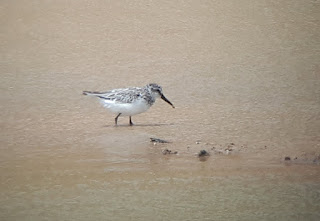Following our epic day, we chilled out and rested our weary paws around Eilat. We checked out Holland Park once we'd emerged from our kennels, seeing little of note except a few Sand Partridges and my first Arabian Babblers. A few raptors had started coming over, so we headed up to the cemetary to see if that would give us a closer view. This proved to be a good move and our impending lunch was postponed as we watched a stream of birds flow over us, heading north. The majority were Steppe Buzzards - we estimated c1,000 birds, along with our first dozen Steppe Eagles, plus a Short-toed Eagle, 125+ Black Kites, two Pallid Harriers and a Marsh Harrier. The female Blue Rock Thrush was still hanging out, but she barely got a glance.
...
On 24th we were up at 4am and piling northeast in the darkness towards Nizzana and a few desert specialities. It turned out the Birding Ecotours and Leica Welsh Red Kites had had the same idea, and we were soon in this mind convoy, heading for the grassy steppe-like plains. We hit our destination just after dawn, and were greeted with the remarkable site of two old WW1 train carriages that had been turned into a bird hide! Slightly surreal.
This railway was constructed by the Turkish military in WW1 to transport troops to the Suez Canal to try and capture it from the British.
After a tense wait, one of the guys picked up a distant MacQueen's Bustard, the target of our quest. Training our scopes on to this stately bird, he suddenly tucked in his head, exploded persil-white feathers out over his breast, and began running along a ridge, in a crazed display. Spectacular stuff!
We watched this superb beast for half an hour or so, before he melted away behind some rocks.To our surprise it started to rain! Next, we turned our attention to some of the other locals, including Bar-tailed Desert Larks and several Cream-coloured Coursers. A shout of 'raptor' got us looking up and we were greeted with the sight of several Steppe Buzzards and two Lesser Spotted Eagles heading over.
C-C C, Nizzana
It was time to leave. A couple of stunning male Pallid Harriers and a close Short-toed Eagle appeared, and an
aucheri Southern Grey Shrike sang sweetly from a thorn bush. Nearby, an Arabian Babbler scolded me as I used the facilities, and a very dark wheatear fooled me into calling Cyprus Wheatear, but closer views revealed it was 'just' a dark female Black-eared. More learning!
We continued on to some saltpans, where a large flock of Ruff huddled against the strong northerly winds with two Curlew. Mark picked up a small falcon sitting on the salt-crust. A Merlin! Very pale and very unexpected; shortly, he powered off across the desert.
A little further on, we saw five Collared Pratincoles leaving the sewage pools we failed to find, but we did see a smart male Ortolan Bunting and a Wryneck on a bit of waste ground. A security guard was interested in what we were up to, so we thought it was best we move on. 20 Steppe Eagles were taking great interest in something south of the road and nearby, towards Mispe, we came across a lush green oasis that just had to be checked out. A smart Masked Shrike, first of our trip, hunted bees from the bushes, but all we could find in the trees were the usual Lesser Whitethroats, a brief male Ruppell's Warbler, some Greenfinches and a couple more Ortolans.
Masked delight.
Terriers at the Oasis
Striped hawkmoth caterpillar
Sde Boqer Kibbutz was our next stop, a rather wooded, fenced community. A stonking Palestine Sunbird showed well in a garden and a few Blackbirds seemed a little out of place. Two impressive pied Egyptian Vultures cruised over and three Wrynecks loafed in the shade of a small copse. A very pale
Tristris-esque Chiffchaff was interesting, but was left unnamed.
Just south, a couple of lined reservoirs held two Little Grebes, whilst overhead the awesome sight of an Alpine Swift enthralled us. On the fence, our target, Desert Finch showed well and we enjoyed great views of these lovely birds as they fed on the track-edge and posed on the barbed wire.
Desert Finches, Sde Boqer Reservoir.
A brief tour of Mispe Ramon failed to reveal the reported Syrian Serins, but we couldn't expect everything to show, so we had a quick look at the Ramon Crater, feeling like proper tourists. Our first Nubian Ibex showed on the rocky slopes and a White-crowned Black Wheatear posed in the car park with a Blackstart.
We headed for Eilat. No carcasses were at the vulture watchpoint and too many birders were at the Sinai Rosefinch wadi, so we didn't bother to stop. A handsome male Hen Harrier drifted along the road just west of Lotan as we approached R90, the sole bird of the trip, and possibly trumping the many male Pallids we had seen in terms of looks.
We were due back at the IBRCE in Eilat, for the Bird Race talk. Greetings, stories and gen were swapped freely with the other teams and we took careful note of the rules. Good spirits, and mounting excitement for the race were much in evidence, for the day after tomorrow.
































































